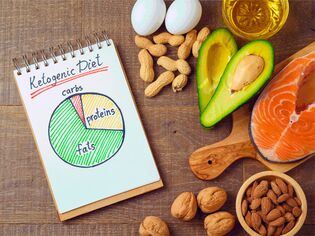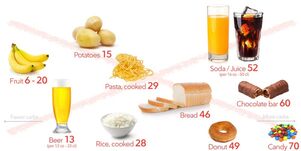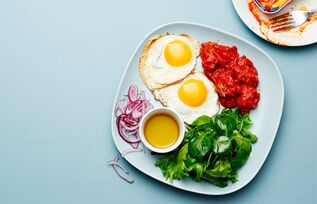
Fashion bloggers and glossy magazines everywhere are shouting about different weight loss methods: a diet without gluten, the Kremlin, fresh juices, blood type and hundreds more. You can argue as much as you want about the effectiveness of each of the methods, but the main question for women is still “how to lose weight? ” Diets often have negative relationships because they involve limitations and concerns, but ketogenic nutrition is one of them. The keto diet is a diet high in fat and protein and minimal in carbohydrates.
How does it work?
Our body is designed to get energy from carbohydrates (glucose). An alternative energy source is the breakdown of fats, or rather so-called ketone bodies. When blood glucose is low (without carbohydrates, this is inevitable), fat reserves are used. By taking them as fuel for the body and the brain, extra inches begin to separate.
Therefore, the goal of a diet is to minimize the amount of carbohydrates in the diet and to maximize the amount of fat consumed.
Remember that any diet is stressful for the body and the body. When choosing a way to lose weight, try to properly assess your health and fitness.
In 2016, scientists and medical experts published the results of a study that examined the effects of a low-carbohydrate diet on the body and risk factors for cardiovascular disease. It was concluded that subjects on a low-carbohydrate diet lost more weight than those who continued to consume carbohydrates. The other side of the coin was that losing weight was associated with an increase in cholesterol, which is not good for health.
Today, there are many techniques aimed at reducing one of the indicators of BJU. The leader of the last few years can be called the Ducan diet - a protein nutrition system consisting of four stages. Which of the ways to give preference is up to you.
What is ketosis?
This is a condition of the body when ketone bodies or ketones become the main source of energy. In order for the body to start working in this mode, it is necessary to fast carbohydrates for 3-4 days and then switch to one of the appropriate keto diets.
Keto Diet Types
Classic.This is a low carb and high fat diet. In fact, the whole article is entirely dedicated to the classic version of the ideal ratio of BJU: 75% fat, 20% protein and 5% carbohydrate.
Cyclic Keto Diet. In this case, a strict adherence to a diet that allows you to replenish glycogen stores, allowing the consumption of 400-500 g of carbohydrates per day, means a change of 5 days and 2 days of so-called "cheating".
This option is most often used before or during increasing and intense sports loads. This type of food helps to speed up metabolism, burn fat and gain lean muscle mass. Many nutritionists insist that a proper diet is balanced, so they prefer it over the listed dietary options.
Targeted Keto Diet.Suitable for professional athletes used by most bodybuilders. In this case, carbohydrate consumption is allowed one and a half hours before the start of training. This type of ketogenic diet allows you to replenish glycogen stores so that you don't run out of ketosis at the same time.
Pros and cons of keto diet
Pros:
- With a ketogenic diet, there is no dramatic change in nutrition and artificial reduction of calories, which usually leads to weight loss and sometimes weight gain after weight loss.
- As a rule, the feeling of hunger disappears and endurance increases.
- Keto diet can help you lose weight. For this reason, public people often use themselves to prepare for emergency shootings or important events.
- Low carb diets are often chosen by people with insulin resistance and metabolic syndrome because of their excellent results and resolution of chronic diseases. Reducing carbohydrates to 25-50 grams of ketogenic per day helps keep insulin levels low and normal.
- The keto diet has been recommended as a drug-free treatment for difficult-to-control uterine epilepsy. This is evidenced by research in 2016.
- For people with type 2 diabetes, it can be helpful to lose excess fat and improve the overall condition. This was reflected in a foreign study in 2018, which involved 2, 500 people. Some of the subjects were low in carbohydrates, while others were more balanced. The main goal of the study was glycemic control. As a result of systematic observations, analysis and comparisons, scientists have come to the conclusion that the keto diet has a beneficial effect on the body and can be used as part of an individual treatment plan under the supervision of a physician.
Cons:
- The most common side effects are constipation, low blood sugar or stomach upset.
- It is less common that low-carbohydrate diets can cause kidney stones or high levels of acid in the body (acidosis). Other side effects can include headaches, chills, occasional fevers, fatigue, irritability, and bad breath, as well as "keto flu. "
- When your body burns fat stores, it puts a strain on the kidneys and raises blood ammonia levels.
- Poor diet and lack of balance. Significant restrictions on food intake occur because carbohydrate intake is minimized.
- Many people initially report general weakness, lethargy, and drowsiness.
- Ketone bodies are quite toxic to the body, so it is important not to deceive fate alone and seek professional advice from a dietitian or doctor who will monitor you during weight loss.
Contraindications
Who Should Avoid Keto Diet?
- People with liver and kidney disease, high cholesterol and metabolic diseases.
- Diabetics are advised to practice nutrition only under the supervision of a doctor.
- Pregnant and lactating women.
What to eat and drink in the keto diet? What foods can you eat?
Unprocessedmeat, ie salting, preservation, smoking, etc. without processes. Suitable for fatty parts of pork, lamb, beef, duck, chicken and turkey, pork and lard. Avoid sausages and sausage products.
Fish and Seafood. Salmon, salmon, saury, sardines, mackerel, herring and any seafood are excellent. Avoid baking bread because it contains carbohydrates.
Egg. Eat in any form: boiled, stuffed, fried in oil, omelet, etc.

Vegetables growing on the ground. Favorites include cauliflower, cucumber, asparagus, avocado, broccoli, spinach, green beans and pumpkin. Say goodbye to root vegetables: potatoes, beets, onions, carrots, celery root, etc. Use olive oil or butter for cooking.
Dairy products: cottage cheese, butter, cheese, cream, sour cream. The main condition is to be brave.
Hazelnuts. Useful for snacks other than cashews. This type is better to exclude because of its high carbohydrate content.
Fats and oils.If we are talking about vegetable oils, prefer olives. Coconut is also very popular, which can significantly diversify the taste palette of dishes.
What to drink?
It is important to drink plenty of fluids in the keto diet, water helps to get rid of toxins in the body.
A 2015 study found that replacing diet drinks with water after a main meal could improve insulin resistance as well as lead to more weight loss.
Eliminate all fizzy drinks and juices, energy drinks and smoothies and beer.
What should I drink other than water? Unsweetened coffee and tea and wine are the least harmful in terms of carbohydrate content.
What foods should be avoided?
First of all, you need to gather all your will in one fist and give up the things you smoke the most: sweets, candy, cake, cookies, chocolate bar, bread and breakfast. Sugar-free diets have long been popular among women around the world, eliminating simple carbohydrates and refined sweeteners, which help reduce the risk of heart disease.

Starchy foods: bread, pasta, rice, corn, potatoes, peas, chips, grains, muesli, etc. If you see the word "whole grain", put the item back on the shelf.
Legumes, avoid beans and lentils first.
Try not to drink milk and say goodbye to the latte (it contains 18 grams of carbohydrates), avoid low-fat yogurt.
The best choices for fruits and berries are raspberries, strawberries, strawberries, watermelons and melons. Bananas, grapes, mangoes, pears, apples and kiwis can break carbohydrate statistics.
A wise man said, "Losing weight without restricting food is like conquering laziness without getting off the couch. "Expect to work hard and change your eating habits.
An example of a weekly keto menu
You will love cooking to diversify your diet and achieve your goals. What can you eat during the week?
Monday
- Breakfast: boiled eggs with ham, cheese and spinach.
- Dinner: chicken broth and vegetable salad decorated with natural mayonnaise.
- Lunch: fish cooked with vegetables (green beans and greens) and brown rice.
Tuesday
- Breakfast: omelette with grated cheese and steamed fish cakes.
- Dinner: tuna salad with a mixture of seasoned avocado and lettuce with olive oil or natural mayonnaise.
- Lunch: meaty vegetable stew.
Wednesday
- Breakfast: toast with boiled egg and cream cheese and avocado.
- Lunch: meaty borscht.
- Lunch: seafood salad and cauliflower pancakes.
Thursday:
- Breakfast: 2 eggs and asparagus fried in oil.
- Lunch: puree soup and vegetable salad.
- Meal: Mushroom casserole.
Friday:
- Breakfast: smoked salmon and avocado sandwich.
- Lunch: fish soup.
- Meal: fresh spinach frittata.

Saturday
- Breakfast: omelette with mushrooms and cheese.
- Dinner: boiled chicken with hummus and lettuce.
- Meal: turkey cooked with cabbage salad and cream cheese sauce.
market
- Breakfast: mushroom casserole.
- Lunch: chicken soup.
- Meal: Chop avocado with fried green beans in butter.
Result: how many people, how to lose so much weight. A ketogenic diet is a short-term diet aimed at weight loss, not health. The results of clinical studies examining the effects of ketogenic diets are controversial, so they should be used for no more than a few months and under medical supervision.






























